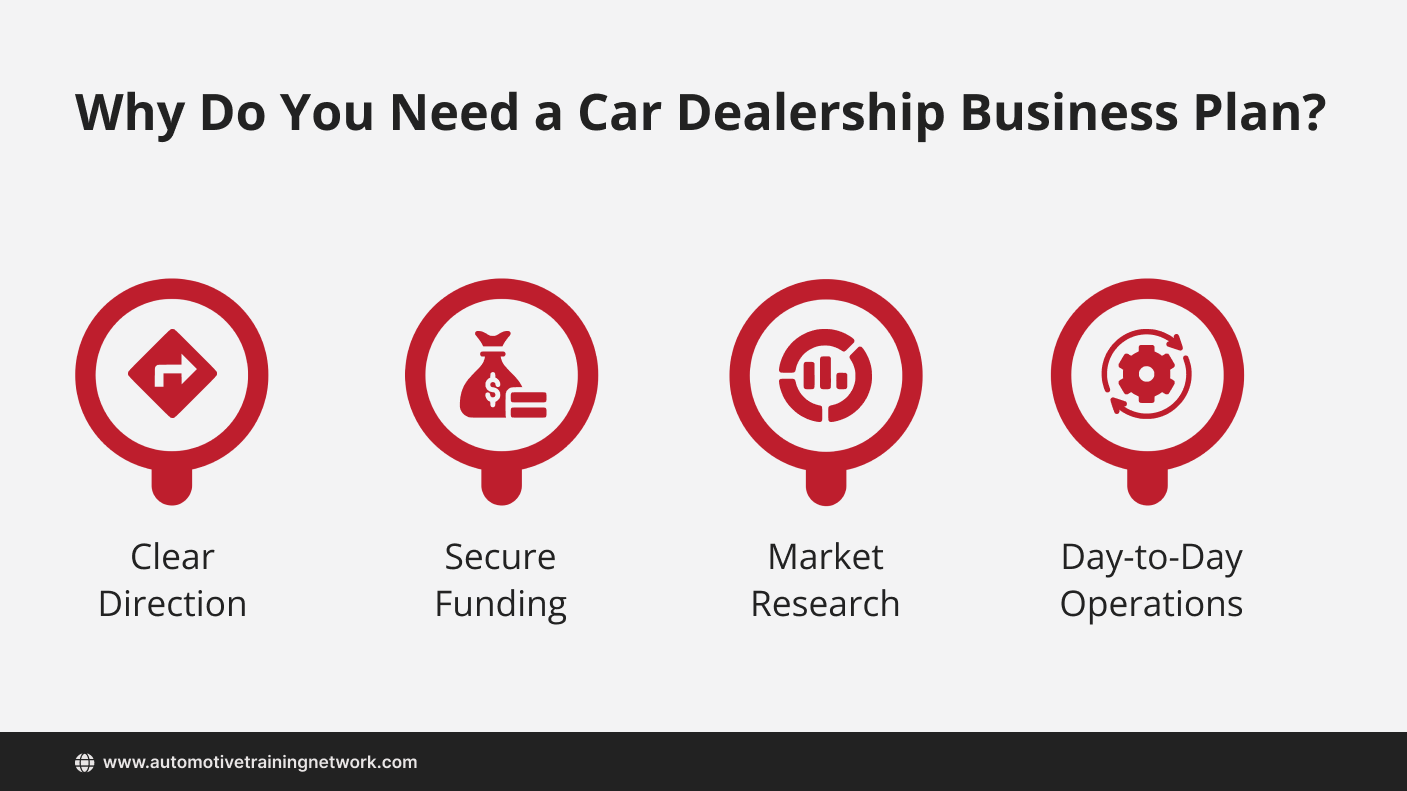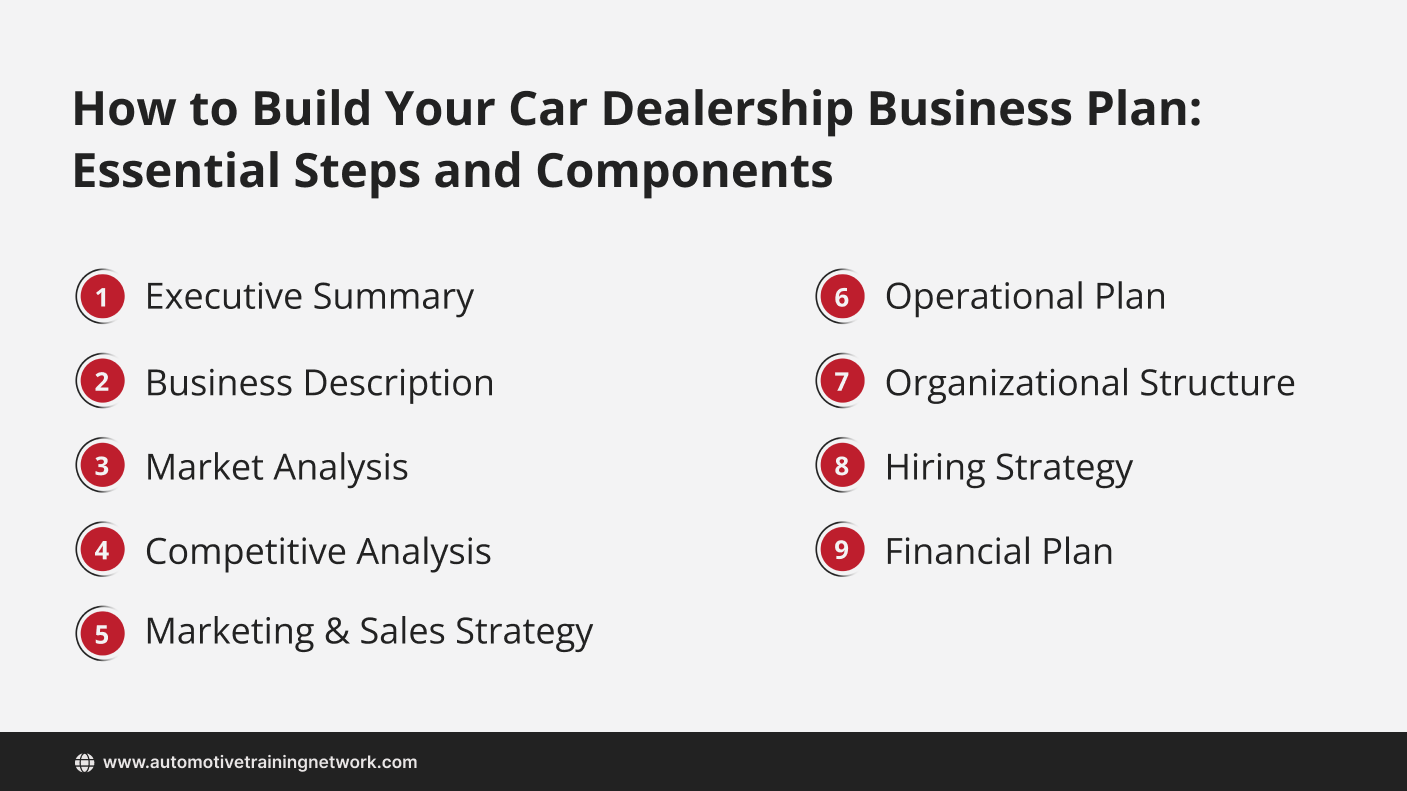Steal This Ready-to-Use Car Dealership Business Plan

Starting a car dealership is an exciting opportunity, but it takes a lot of planning to get it right. Having a business plan is like your roadmap—showing you the way forward as you set up and run your dealership.
With a well-thought-out business plan, you can steer your business in the right direction and figure out all the important stuff at the earliest - like how much money you need, where your dealership should be, who your customers are, how you'll make your sales and more.
With a car dealership business plan, you can manage your resources effectively, and it prepares you to face the challenges that might come your way. It ensures that you’re not just reacting to situations as they arise but are proactively managing your business with a strategic approach that helps you stay ahead, reduces risks, and sets you up for success.
Why Do You Need a Car Dealership Business Plan?

A car dealership business plan is essential for several reasons, particularly because it acts as a roadmap for your business’s future and is often necessary to secure financing. Here’s why having a detailed auto dealership business plan is crucial:
- Clear Direction: It outlines your business goals, strategies, and the processes you will use to meet your sales and financial objectives.
- Secure Funding: A well-prepared business plan shows lenders and investors that you have done your homework, understand the market, and have a clear plan to make your dealership successful.
- Market Research: With a business plan involves researching your local market and helps you understand your potential customers, identify competitors, and spot trends.
- Day-to-Day Operations: To ensure that your dealership's operations are as efficient as possible, it helps to understand how you'll run it daily, including staffing, marketing, and inventory management.
How to Build Your Car Dealership Business Plan: Essential Steps and Components?

Follow these steps to make a new dealership business plan for your business from scratch.
1. Executive Summary
Start by introducing the name and location of your business, along with the types of cars you will offer - whether new, used, or both. Clearly state the unique selling propositions (USPs) that set you apart from competitors.
For instance, highlight your competitive pricing, exceptional customer service, wide selection of vehicles, or any exceptional options you provide.
Finish by outlining your core business objectives. These might include achieving a certain market share, expanding your inventory, increasing sales through strategic marketing, or building long-term customer relationships. Make sure to emphasize how these objectives contribute to your dealership's overall success and growth.
Before you move to the next step, check whether the executive summary conveys your dealership's vision, competitive advantages, and goals.
2. Business Description
Begin by explaining the business structure. If your dealership operates as a Limited Liability Company (LLC), describe how this structure provides liability protection and tax benefits, enhancing the dealership's operational efficiency.
Next, focus on the variety of car brands and models you offer. Whether you’re making a small dealership business plan or a high-end one, it is important to mention if you'll offer a mix of luxury and economy cars or include both new and used options.
Finally, outline your budget and financial goals and explain how you've planned your budget to cover important costs such as buying cars, renting space, paying staff, and promoting your dealership.
Before you finish, set clear goals for how many cars you want to sell and the revenue you aim to earn in the first few years. These targets are based on your research into what customers in your area want and how best to reach them.
It will help potential investors or partners understand how your dealership operates, what you sell, and how you plan to make money.
3. Market Analysis
Once the business description is complete, set the stage by discussing how your dealership aligns with the present industry. This step is non-negotiable for all, whether you’re making a small car dealership business plan or a luxury car dealership business plan.
Next, describe your target customers. Who are they? What are their preferences when buying a car? Understanding these demographics helps tailor your marketing and sales strategies effectively.
Then, analyze customer buying behaviors. How do most customers decide on a car purchase? Are they influenced by online reviews, word-of-mouth, or the availability of financing options? Analyzing this can guide how to approach potential customers and what services or features you should focus on.
Lastly, identify the specific needs your dealership aims to meet. Perhaps, there is a demand for a more personalized car buying experience, or maybe your local market lacks a variety of electric vehicle options.
By the end, you should be well aware of the car dealership industry trends, your target market, and your business's strategic positioning to meet customer demands.
4. Competitive Analysis
Once you’ve examined the market as a whole, the next step in developing your car dealership business plan is to focus on your competitors.
List down other car dealerships in your area. Consider all types—from the big franchise dealerships to the smaller independent ones. Take a close look at what each competitor does really well. This could be anything from offering competitive prices, having a wide selection of cars, strong marketing strategies, great customer service, or even a prime location.
While you’re looking at their strengths, also pay attention to where they might be lacking. Maybe their customer follow-up is weak, or they have a limited selection of hybrid or electric vehicles. These gaps allow you to step in and meet customer needs that others are missing.
Now, think about what sets your dealership apart from these competitors. This is your chance to highlight your unique selling points (USPs). Perhaps you offer better warranties, more personalized service, a modern repair shop, or flexible financing options that others don’t. These features will make your dealership stand out and attract customers.
Understanding your competitors' strengths and weaknesses and clearly defining your dealership’s advantages will help you carve out a strong position in the market. This will draw in customers and set the foundation for a successful and enduring business.
5. Marketing & Sales Strategy
After analyzing your competition, the next step is to create a marketing and sales strategy highlighting what makes your car dealership unique that will smoothly guide potential customers from their first inquiry to purchase.
Begin with a marketing strategy that combines digital and traditional methods - like search engine optimization to increase your website's presence, targeted ads to pull in traffic, and social media campaigns to engage with potential buyers.
And don’t forget to highlight your dealership's unique selling points (USPs) in all your promotions. Whether it’s your unbeatable prices, a wide selection of cars, or top-notch customer service, make sure these features are clear and prominent because they will draw people to your dealership.
When someone shows interest in a vehicle, whether online or in person, your team should be ready to respond promptly and effectively. Train your team to listen to customers' needs and offer useful information to help them smoothly move from test driving to purchasing.
6. Operational Plan
After defining your marketing and sales strategy, the next critical component of your auto dealership business plan is preparing an operational plan. This section will outline how your dealership will run daily, covering location, facilities, inventory management, technology, and service operations.
First, write down your dealership's location and facilities, and try to choose an accessible and visible location to attract maximum foot traffic. And, don’t forget to check if there is ample parking for both customers and inventory.
Next, focus on inventory management that allows you to track which cars you have, where they are, and their readiness for sale. Efficient inventory management helps maintain a balanced vehicle stock that meets your sales targets and customer preferences.
If your dealership includes service and maintenance operations, outline how this will be handled. Having an on-site service center can be a significant advantage, providing customers with convenient access to maintenance and repair services.
7. Organizational Structure
After you've laid out your operational plan, it's time to create an organizational structure for your auto dealership business plan. This step helps you clearly show who is in charge of what and how the different parts of your dealership work together.
- Company Manager – This person runs the entire dealership, ensuring all departments work together to achieve the business goals.
- Assistant Manager – The role supports the Company Manager by taking care of daily operations and helping to organize staff and resources to keep everything running smoothly.
- Bodyshop Manager – The individual in charge of the body shop makes sure that all vehicle body repairs meet the highest standards from start to finish. There are supervisors, refinishers and apprentices who report to the manager.
- Paint Manager – This person leads the paint department, ensuring all painting operations result in high-quality vehicle finishes. They coordinate regularly with the supervisor, painter, and apprentice.
- Auto Electrical Manager – The manager looks after the auto electrical department, overseeing the repair and maintenance of the electrical systems in vehicles. There are supervisors, technicians, and apprentices who report to the manager.
- Mechanic Manager – The individual oversees the mechanical department, managing all vehicle engine repairs and mechanical system maintenance. There are supervisors, mechanics, and apprentices who report to the manager.
- Parts Manager – The manager makes sure the dealership has all the necessary vehicle parts in stock and manages the inventory effectively. There are also supervisors, distributors, and apprentices who report to the manager.
- Sales Manager – This individual heads the sales department, focusing on strategies to boost sales and improve customer satisfaction. The manager is also responsible for managing supervisors and assistants.
- Valeting Manager — This manager is responsible for managing valeting and ensuring that the services are thorough. The vehicle is impeccably cleaned and meets quality standards before being shown or returned to customers.
8. Hiring Strategy
After finalizing the organization strategy, the next step is establishing a powerful hiring strategy for your automotive dealer business plan. This strategy is crucial for assembling a team that meets your dealership's current needs and is equipped to handle future challenges and opportunities.
Create detailed job descriptions for each position in your dealership. These descriptions should clearly communicate the roles and responsibilities, necessary skills, and qualifications that candidates must possess. These details will help you attract individuals who are capable, genuinely interested in the role, and aligned with your dealership's goals.
Apart from that - choosing the right avenues for recruitment is vital. For sales and customer service roles, platforms like LinkedIn and Indeed are excellent for reaching a wide audience.
The Employee Value Proposition (EVP) you offer is critical in attracting and retaining talent. Try to highlight what makes your dealership a great workplace—be it competitive pay, health benefits, a path to career advancement, or a positive and supportive work environment.
By thoroughly addressing these components—your hiring strategy will support your current operational objectives and lay a strong foundation for sustained success and growth in your car dealership.
9. Financial Plan
After setting up your hiring strategy, the last step is creating a financial plan to guide your business's financial health and growth.
Start by clearly stating the total amount of capital you need, that is, your “Funding Ask” to launch and maintain your car dealership over a specified period (e.g., the first five years). This figure should be a sum of your startup costs, property fees, employee salaries, insurance cover, inventory, legal expenses, registration and the ongoing expenses your financial projections have identified.
Specify the types of financial instruments you are considering to cover these costs. These could include:
- Equity Financing: Selling a percentage of your business to investors.
- Debt Financing: Obtaining loans from financial institutions or through programs like the Small Business Administration (SBA).
- Grants: Exploring free-money options available through government or private grants.
For loans, explain what portion of your total funding they'll cover and your plan for paying them back. For selling equity, mention how much of your business you're willing to give up and at what business valuation.
Next, explain how you plan to spend the money. Use a pie chart to show the main costs, such as buying cars for inventory, getting land or a building for the dealership, covering daily costs like marketing and salaries, and setting aside money for big future upgrades or expansions.
Finish with financial projections, estimating how much money you expect to make, when you think the business will start making a profit, and how long it will take to break even (cover all your costs from your sales). Back up your financial plans with data from your projections to show you have a solid understanding of what you need and to build confidence with potential investors or lenders.
This will help you manage finances efficiently, ensuring you have enough cash to cover costs and seize growth opportunities.
Car Dealership Business Plan Example
This is a business plan template for used car dealerships and new cars. So, download the car sales business plan template that can help you create an apt business plan for your dealership:
Download this car dealership business plan template.
Boost Your Dealership’s Success with ATN’s Expert Training!

While having a car dealership business plan is important, it alone cannot guarantee success. To truly capitalize on the business plan, dealerships must ensure their teams have the necessary expertise and skills.
By integrating expert training from the Automotive Training Network into the overall strategy, dealerships empower their teams to implement the business plan effectively and adapt to evolving market demands. We bring the industry expertise of over four decades to your dealership with personalized virtual training, sales & BDC bootcamps, or live in-dealership training programs.
Let us help you turn your business goals into reality.
